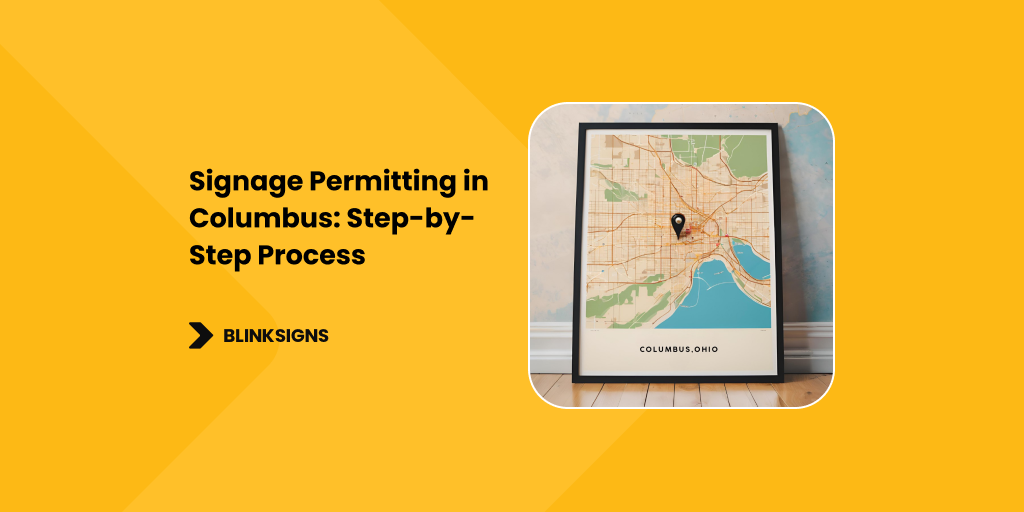
Signage Permitting in Columbus: Step-by-Step Process
In Columbus, effective signage is essential to connect businesses with their customers while maintaining compliance with local regulations. Signage permits ensure your signs align with safety standards and uphold Columbus’s urban aesthetics. Whether you’re opening a store in the vibrant Short North Arts District or along bustling High Street, signage permitting is the foundation of a successful business presence.
In Columbus, regulatory bodies, including the Columbus Department of Building and Zoning Services, the Ohio Department of Transportation (ODOT), and the Columbus City Council, play an active role in signage compliance. These entities enforce rules to create a cohesive visual landscape, promote public safety, and protect Columbus’s unique character. Understanding these requirements is essential for any business looking to make an impactful, compliant signage investment in the city.
Understanding Sign Permits and Regulatory Authorities
A sign permit in Columbus is a legal authorization that allows businesses to install signage on their premises. It ensures that each sign meets specific standards for safety, size, lighting, and placement as outlined by the city’s Zoning Ordinance and Land Development Code. Sign permits reduce the risk of penalties, create consistency in Columbus’s cityscape, and assure businesses that their signage meets city and state regulations.
Key Regulatory Authorities
Multiple entities oversee Columbus signage regulations:
- Columbus Department of Building and Zoning Services: Manages permits for sign placement, size, and structural standards.
- Ohio Department of Transportation (ODOT): Regulates signage near highways, ensuring visibility and safety.
- Columbus Historic Resources Commission: Reviews signage in historic areas to maintain the city’s architectural integrity.
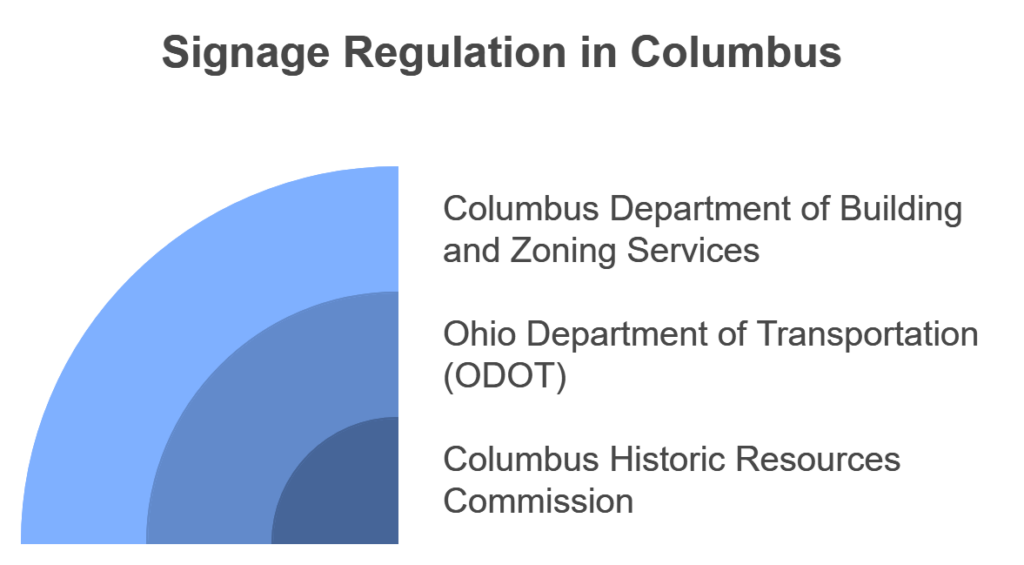
Signage Regulations in Columbus
These authorities play distinct roles, ensuring that signage is safe, compliant, and aligned with Columbus’s aesthetic and community standards.
Legal Basis for Regulation
The basis for signage regulations in Columbus is embedded in Columbus’s Municipal Code, which includes zoning rules and Ohio state statutes. These regulations prioritize public safety, community aesthetics, and environmental preservation to foster a clean and cohesive urban landscape. Each sign must adhere to these legal guidelines, and BlinkSigns is here to support businesses through every step, from installation to application.
Types of Signage and Their Specific Requirements
On-Premise vs. Off-Premise Signs
Columbus distinguishes between on-premise signs installed directly on the business property and off-premise signs, like billboards and digital displays promoting businesses at other locations. Each type has a unique size, height, illumination, and placement regulations.
- On-Premise Signs: These include wall signs and monument signs directly associated with the business location.
- Off-premise Signs: These are typically billboards located along highways and main roads, and they must meet strict ODOT guidelines for visibility and placement.
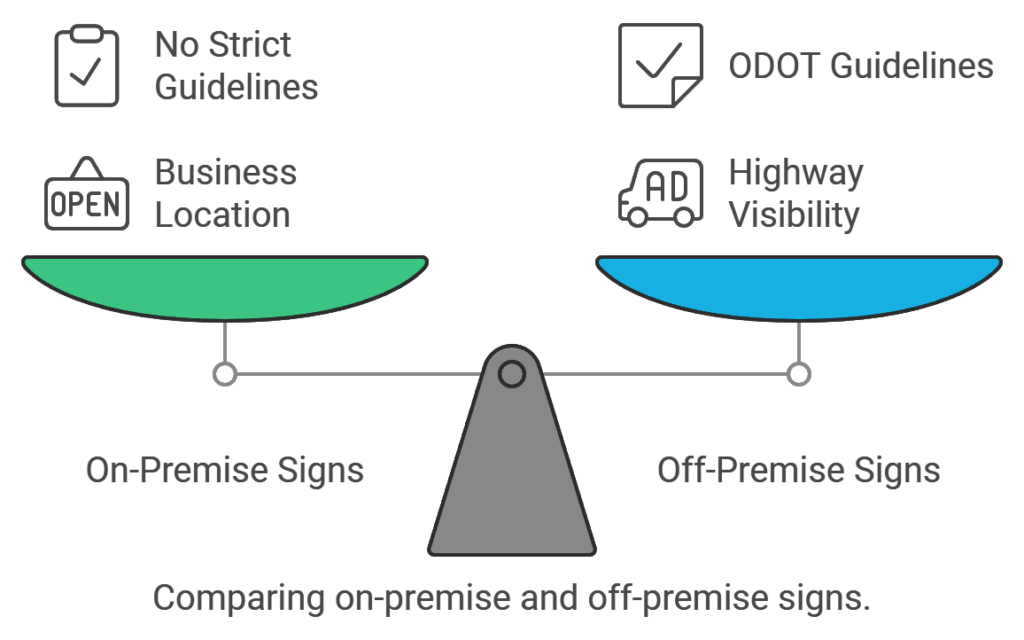
Columbus On-premise and Off-premise signs comparison
Common Sign Types and Their Compliance Standards
Columbus has specific regulations for various sign types to ensure they fit into different zoning areas. Here’s a look at the compliance standards:
- Wall Signs: Typically regulated by height and size to prevent obstruction of other buildings.
- Monument and Pylon Signs: Require robust structural standards to withstand Columbus’s weather conditions.
- Electronic Message Centers (EMCs): These digital signs are limited in brightness, animation, and operating hours.
- Temporary Signs: Banners, real estate signs, and A-frames have placement and duration restrictions to reduce visual clutter.
Prohibited Signage Types
Certain sign types are restricted under the Columbus Code to maintain aesthetics and public safety. These include flashing signs, excessively bright digital billboards, and signs with distracting features near residential or scenic areas.
The Columbus Sign Permitting Process: Step-by-Step Guide
Navigating Columbus’s sign-permitting process can feel overwhelming, but a structured approach simplifies the journey. Here’s a breakdown of each step:
1. Application Preparation and Submission
To apply for a sign permit, you’ll need to prepare specific documentation, including site plans, elevation drawings, and, if required, electrical permits for illuminated signs. Complete and accurate documentation is crucial for a smooth process.
2. Plan Review and Approval Process
After submission, the Columbus Building Department and City Planning Division review applications. This includes a thorough assessment of zoning and building codes to ensure compliance. The review timeline may vary based on sign complexity and location, with digital or illuminated signs typically requiring additional scrutiny.
3. Inspection Requirements and Compliance Checks
Once the permit is approved, an inspection confirms that the sign’s structure, electrical components, and overall installation meet Columbus’s safety and code standards. This inspection process ensures public safety and compliance with the Columbus Municipal Code.
4. Permit Issuance and Installation Guidelines
Businesses receive their final permit upon passing inspection. To avoid penalties, installation must align with city guidelines for size, placement, and structural integrity. BlinkSigns guides each client through these steps, making compliance straightforward and stress-free.
Neighborhood and District-Specific Requirements
Columbus’s neighbourhoods have unique guidelines that reflect the area’s character and community goals. Here’s what to consider in each:
| Neighbourhood / District | Signage Requirements | Special Considerations |
| Downtown Columbus | – Height Restrictions: Signage must align with height limits to maintain skyline visibility.
– Density Controls: Limits on the number of signs per block to prevent overcrowding. |
– Digital and illuminated signs must follow strict brightness and operational hour restrictions.
– Permits are more likely to be required for illuminated or projecting signs due to the high volume of foot traffic and visibility concerns. |
| Short North Arts District | – Design Standards: Artistic, creative designs are encouraged but must meet the area’s aesthetic guidelines.
– Material Requirements: Must align with unique artistic style and community vibe. |
Local arts boards may require additional reviews to ensure compliance with the area’s artistic vision.
– Projecting and neon signs are popular here but must adhere to artistic and structural standards. |
| German Village | – Historic Preservation: Signs must fit the historic aesthetic, typically favouring wood and metal.
– Subdued Color Schemes: Bright colors and modern materials are discouraged. |
– Strict reviews from the Historic Resources Commission.
– Custom materials and designs may be required to align with the village’s historic preservation goals. – Neon, digital, or illuminated signs are generally discouraged in this area. |
| University District | – Temporary Signage Allowed: Permits granted for temporary signage due to student events and seasonal promotions.
– Educational Themes Encouraged: Signs can reflect the academic environment and student engagement. |
– Temporary permits may require renewal, particularly for A-frame or banner signs.
– Restrictions apply for illuminated signs near residential areas to avoid disruption to student housing. |
| Arena District | Digital Display Limitations: The brightness and animation of digital signs must be controlled to prevent driver and pedestrian distraction.
– Size and Placement Controls: Large-scale signs are regulated in size. |
– Increased restrictions on operating hours for digital displays to avoid interference with nearby entertainment venues.
– Compliance with district-wide design themes may require additional review by zoning boards or entertainment oversight committees. |
| Italian Village | – Historic Compatibility: Designs should respect the Italianate architecture with natural materials like brick or wood.
– Lighting Controls: Restricted illumination standards to preserve the neighbourhood’s charm. |
– Height and size restrictions are in place for projecting and illuminated signs.
– Special approvals may be needed from local historic review boards to ensure new signage complements the historic architecture and community aesthetics. |
| Clintonville | – Community-Focused Aesthetic: Simple, neighborhood-friendly designs encouraged.
– Limited Size and Placement: Signage should not obstruct natural scenery or residential views. |
– No illuminated signs allowed near residential areas.
– Setback and clearance requirements are enforced to protect residential visibility and community atmosphere. – Local zoning boards may require signs to align with Clintonville’s green initiatives. |
| Franklinton | – Modern and Industrial Styles: Signs should reflect the district’s industrial heritage and artistic community.
– Size and Density Limits: Number of signs restricted in high-density commercial zones. |
– Additional permissions may be required for murals or artistic installations to align with Franklinton’s reputation as a creative hub.
– Temporary permits may be issued for events or installations that support the area’s cultural events. |
| Grandview Heights | – Suburban Standards: Height and size restrictions apply to keep signage in scale with neighbourhood buildings.
– Illumination Restrictions: Limited hours for illuminated signs, especially near residential zones. |
– Digital and neon signage discouraged in favour of traditional designs.
– Community review may be required to ensure signage reflects the residential and family-oriented atmosphere of the area. |
| Brewery District | – Traditional Materials: Preference for materials that match historical brewery styles, like brick and iron.
– Height and Placement Limits: Signs should not detract from the architecture of historic breweries. |
– Additional design review by zoning boards to maintain the neighbourhood’s historical integrity.
– Restrictions on illuminated and digital signage to preserve the district’s ambience and blend with architectural heritage. |
| Olde Towne East | – Vintage and Historic Look: Signs should match the historic architecture and character of the district.
– Limited Digital Displays: Digital signs are generally discouraged in favour of traditional signage. |
– Height and colour restrictions enforced to ensure signs do not clash with historic homes.
– Materials like wood, wrought iron, and natural finishes are encouraged to align with the district’s preservation goals. |
| Polaris and Easton Areas | – Commercial-Friendly Standards: Higher allowances for size and illumination in these retail-focused areas.
– Digital Signage Permitted: Digital displays are encouraged but must meet brightness and operational limits. |
– Large retail zones may have greater Height and size allowances but require zoning approval.
– Compliance checks to ensure digital signage does not interfere with pedestrian and vehicle traffic visibility. |
| Other Residential Neighborhoods | – Minimalist Aesthetic: Small, unobtrusive signs are encouraged to preserve residential aesthetics.
– Limited Illumination: Brightness and hours of operation are restricted in family-oriented neighbourhoods. |
– Strict setback requirements to avoid visual intrusion on residential properties.
– Local community boards may review signage for compatibility with neighbourhood aesthetics and to maintain a cohesive residential look. |
ADA and Accessibility Requirements for Columbus Signage
ADA Compliance Standards
In Columbus, signage must adhere to ADA standards, ensuring accessibility for all. This includes requirements for Braille, non-glare finishes, and proper height for readability by visually impaired individuals. BlinkSigns specializes in ADA-compliant signage to ensure every customer is served.
Visibility and Readability
ADA standards mandate specific font sizes, contrast levels, and placement heights to make signs accessible to individuals with various abilities. Ensuring compliance with these standards enhances customer experience and ensures inclusivity.
Inspections for Accessibility Compliance
Columbus conducts periodic inspections to ensure ADA compliance, especially for businesses serving the public. BlinkSigns works proactively to ensure every sign installation meets accessibility requirements.
Permitting Fees and Associated Costs for Columbus Signage
Navigating the costs involved in the signage permitting process is crucial to budgeting for compliant signage in Columbus. Permit fees vary by sign type and location, with higher fees in historic areas and commercial zones like Downtown Columbus.
Permit Fees by Sign Type and Location
The fee structure is dependent on factors such as sign size, lighting features, and zoning district. For example:
- Small business wall signs in commercial areas often incur moderate fees.
- Digital displays and electronic message centers (EMCs), particularly in high-traffic districts, may have higher permit costs due to additional reviews.
Additional Costs
Beyond the initial permit, businesses should be prepared for inspection fees, renewal costs, and fees for specific permits, such as electrical permits for illuminated signs. Bond requirements also apply in some districts, ensuring businesses can cover removal costs. BlinkSigns provides clients with a transparent breakdown of fees for informed financial planning.
Cost Overview for Major Columbus Neighborhoods
Specific Columbus neighbourhoods, such as Short North and the University District, have unique fee structures based on traffic volume and proximity to cultural hubs. BlinkSigns’ experience in these districts ensures our clients are prepared for location-based fees and know how to budget effectively for high-impact signage.
Compliance with ODOT Regulations for Highway and Scenic Signage
ODOT regulates signage along Ohio’s highways and scenic routes. For businesses near major roadways, meeting ODOT’s standards is essential for visibility without compromising driver safety.
Highway Signage Requirements
ODOT mandates strict spacing, height, and visibility standards for state road signage. This includes controls on lighting intensity and sign spacing, ensuring that each sign is clear without overwhelming drivers.
Scenic Byways and Protected Areas
In scenic or protected areas, Columbus requires businesses to follow regulations that prioritize environmental preservation. For example, signs near scenic byways must meet restrictions on size and illumination to blend with the natural surroundings. BlinkSigns helps businesses meet these requirements to achieve visibility while preserving Columbus’s scenic charm.
Prohibited Signs Along Highways
ODOT restricts sure signs along highways, such as flashing signs
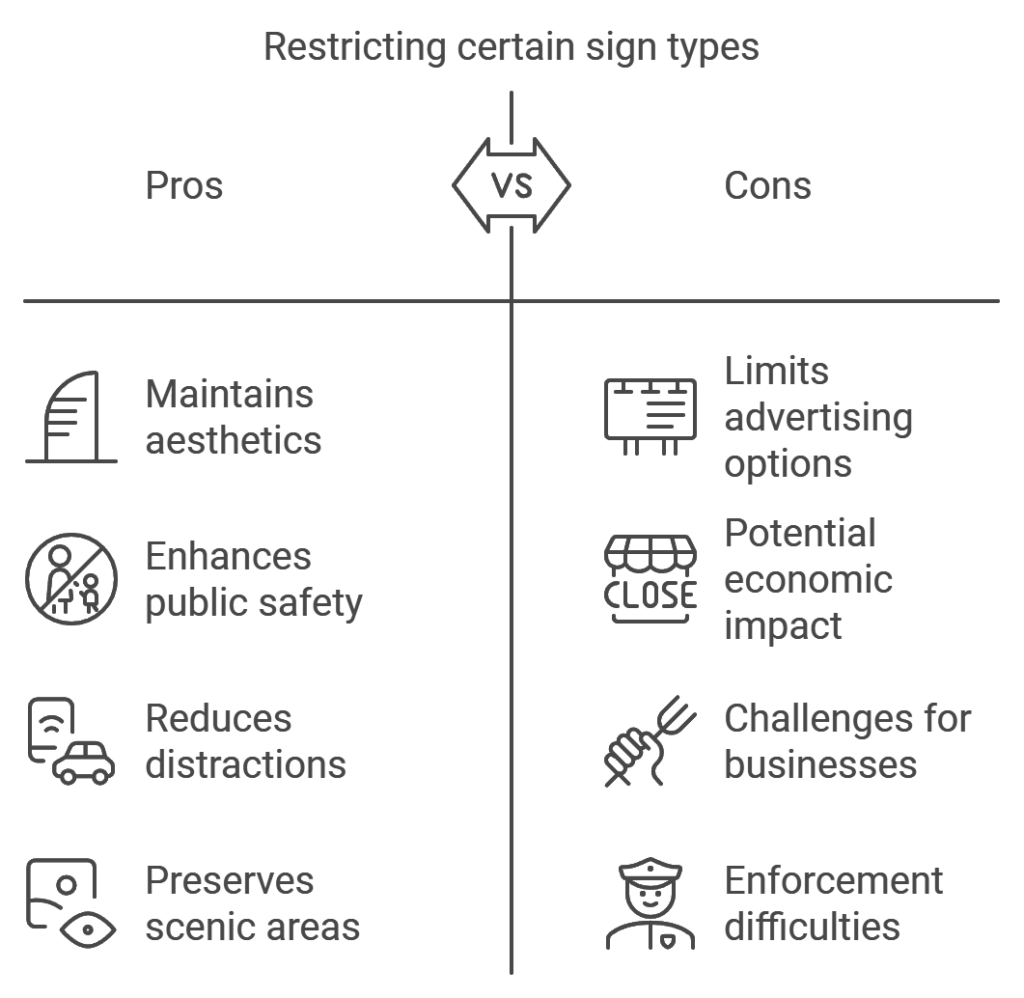
Prohibited Signs Along Highways
and oversized billboards. These limitations prevent distractions and maintain safe driving conditions. Our team at BlinkSigns stays updated on ODOT regulations, ensuring every sign we install near highways adheres to these standards.
Variance and Appeal Process for Columbus Sign Permits
Occasionally, businesses may require a variance beyond standard Columbus signage limits, whether for unique size needs or placement challenges.
When to Apply for a Variance
A variance is necessary when a business seeks to exceed typical height or setback limitations. This can be particularly relevant for companies near large commercial zones or buildings with unusual architectural layouts.
Submitting a Variance Request
Submitting a variance request involves gathering detailed documentation, including site plans, justification for the request, and evidence that the variance aligns with neighbourhood goals. BlinkSigns assists clients in preparing these requests to increase the chances of approval.
Appeal Process for Denied Permits
The Columbus Board of Zoning Adjustment offers an appeal process if a sign permit application is denied. This requires a formal application, additional documentation, and a clear explanation of the need for reconsideration. BlinkSigns navigates clients through this process, helping them meet Columbus’s standards for appeals and variances.
Maintenance and Renewal of Columbus Sign Permits
Keeping Columbus signage compliant is an ongoing process that includes regular maintenance and permit renewals.
Ongoing Maintenance for Compliance
All permitted signs, especially illuminated and digital signs, must undergo regular inspections and maintenance checks to meet Columbus’s safety standards. BlinkSigns helps clients schedule routine maintenance, ensuring every sign meets lighting and structural integrity requirements.
Permit Renewal Processes
Signage permits in Columbus often require annual renewals. Temporary signs, such as banners and construction signage, may need renewal every few months. Renewal involves submitting updated site plans and inspection reports to maintain compliance.
Compliance Checks and Recordkeeping
Maintaining records of all permits, inspections, and renewals is essential to avoid fines or enforcement actions. BlinkSigns helps businesses streamline record-keeping for efficient renewal processes, ensuring a history of compliance that protects your investment.
Environmental and Aesthetic Standards for Columbus Signage
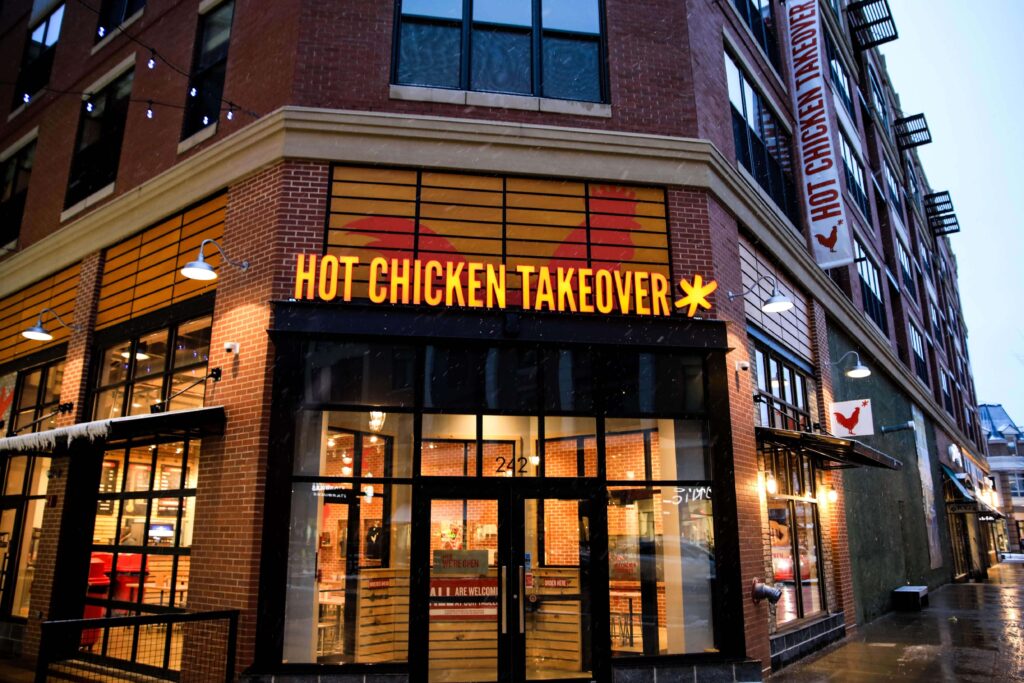
Hot Chicken Takeover Signage
Environmental and aesthetic standards in Columbus aim to preserve the city’s character and protect residential areas from unnecessary visual or auditory impact.
Light Pollution and Noise Standards
Columbus enforces light pollution standards to minimize excess brightness in residential areas. Signs, particularly digital displays, must adhere to brightness limits and may have restricted hours of illumination.
Eco-Friendly Materials and Practices
Businesses are encouraged to use sustainable materials and energy-efficient lighting like LED to minimize environmental impact. BlinkSigns offers eco-friendly signage solutions that comply with Columbus’s sustainability initiatives and help businesses create a responsible, compliant presence.
Design Standards for Historic and Scenic Areas
Historic areas such as German Village and Short North Arts District have strict aesthetic guidelines for signage. Signs must often use muted colours, traditional materials, and subdued lighting to fit seamlessly with these areas’ architectural themes. BlinkSigns specializes in creating customized signage that reflects the character of each district while meeting all aesthetic and environmental requirements.
Taxes and Financial Considerations for Columbus Signage
Tax implications and financial planning are crucial for businesses investing in signage in Columbus.
Tax Implications for Permanent and Large Signs
In Columbus, large and permanent signs, such as billboards and pylon signs, are subject to property taxes. Businesses must factor these taxes into their financial planning, as assessments depend on the sign’s size, location, and visibility.
Tax Deductible Expenses for Businesses
Certain signage expenses, such as permit fees, inspection costs, and renewal fees, are often tax-deductible, providing businesses with opportunities to reduce overall expenses.
Investment Strategies for Compliant Signage
BlinkSigns helps clients create strategic investment plans that balance compliance and cost-effectiveness. By optimizing the placement, design, and materials used in signage, businesses can achieve a high-impact, compliant presence in Columbus while managing their expenses efficiently.
Special Considerations for Business Signage in Historic and Protected Areas
Compliance is essential for historic and environmentally sensitive businesses to align with local preservation goals.
Historic District Requirements
In districts like German Village and Short North, signage must adhere to traditional styles, often avoiding bright colours or modern materials. BlinkSigns offers customized solutions that align with these historic aesthetic standards, ensuring a sign that enhances the brand and location.
Environmentally Sensitive Zones
Columbus imposes additional regulations on parks, rivers, and scenic zones, limiting sign size and illumination to maintain natural beauty. Businesses in these zones must use environmentally friendly materials and meet strict guidelines to remain compliant.
Preservation Standards
Preservation standards in Columbus ensure that all signage reflects the character of historic and scenic areas. BlinkSigns works closely with clients in these locations to design signage that supports Columbus’s preservation goals while achieving adequate visibility.
Additional Resources for Columbus Signage Permitting
Columbus offers numerous resources to assist businesses in navigating the signage permitting process.
Essential Links and Contact Information
Access links to the Columbus Building Department, ODOT, and local zoning boards for guidance on specific requirements.
Permitting Checklists and Templates
Downloadable checklists and templates can streamline the application process, ensuring all documentation is complete before submission.
Professional Signage Services
Working with professional signage experts like BlinkSigns simplifies the compliance process. Our team ensures each step is handled effectively, from installation application to providing clients with peace of mind.
FAQs for Signage Permitting in Columbus
Do I need a permit for a new business sign in Columbus?
Yes, new business signs in Columbus typically require permits to ensure compliance with city regulations on size, placement, and aesthetics.
What documentation is needed for a Columbus sign permit application?
You’ll need site plans, elevation drawings, and details on illumination and materials. This helps Columbus Building and Zoning Services assess compliance.
Are there specific rules for signs in historic Columbus neighbourhoods?
Yes, areas like German Village and Short North have unique guidelines requiring signs to complement the historical aesthetic, often with material and colour restrictions.
How can I determine if my sign placement meets Columbus zoning rules?
Check with Columbus zoning ordinances, as they regulate setback, height, and placement, especially in commercial and residential areas.
What’s the difference between on-premise and off-premise signs in Columbus?
On-premise signs advertise a business at its location, while off-premise signs, like billboards, promote entities elsewhere. Each type has distinct permitting rules.
Can seasonal or event signs be displayed without a permit in Columbus?
Temporary signs, including event banners or seasonal signs, often require a permit with specific duration limits to maintain compliance.
Are there restrictions on illuminated signage in Columbus residential areas?
Yes, illuminated signs near residential zones must comply with brightness and operating hour limits to reduce light pollution and neighbourhood disruption.
How often must signage permits be renewed in Columbus?
Permanent signage usually doesn’t require renewal, but temporary permits often need periodic renewal based on city guidelines.
What penalties could I face for installing an unpermitted sign in Columbus?
Installing an unpermitted sign may lead to fines, removal orders, or operational delays. Compliance checks help avoid these issues.
Can I appeal if my Columbus sign permit application is denied?
You can file an appeal through the Columbus Board of Zoning Adjustment, providing reasons and documentation to support your case.
Conclusion: Your Guide to Seamless Signage Permitting in Columbus
Navigating signage permitting in Columbus doesn’t have to be complex. With the proper knowledge and resources, businesses can create impactful signage that complies with local standards. BlinkSigns supports clients through each step, from obtaining permits to designing ADA-compliant and aesthetically appealing signs.
For Columbus businesses, compliant signage is a long-term investment that enhances brand visibility and upholds the city’s unique character. Contact BlinkSigns for expert assistance in creating a signage solution that aligns with your goals and complies with every requirement.